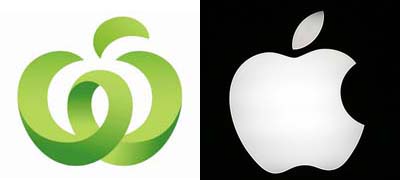Woolies' Apple logo dispute drags on

Supermarket chain Woolworths has asked for more time to respond to intellectual property administrator IP Australia over a trademark dispute lodged by Apple last year concerning its logo.

The logos in question
(Credit: Woolworths and Apple)
Woolworths lodged the new trademark in August 2008: the letter W, formed in the shape of a peeled apple with a leaf on top. Although IP Australia made public in December that it had accepted Woolworths' application for the trademark (for the supermarket to be able to keep it), the application for the logo still needed to withstand any opposition it might encounter.
Unfortunately for Woolworths, Apple didn't like the similarity of the revamped brand to its own carefully guarded stamp and filed opposition to the registration, which also covered product categories such as computers, in March.
Since then, Apple has filed the evidence in support of its opposition to the trademark application. Woolworths now has to respond to that evidence. The supermarket had been due to file a response on 27 January, but on that date, the company's trademark attorney, Spurson and Ferguson Fang, lodged an extension which would give it an additional three months to do so.
Even though Woolworths had asked for an extension of time, it may, in a few months time, ask for a further extension, a spokesperson for IP Australia told ZDNet.com.au. Once evidence is submitted, Apple will then need to supply its evidence in reply.
"Evidence in reply [from Apple] was due approximately six months after Woolworths lodges their reply to Apple's claims. That time may also be extended by Apple," the spokesperson said.
Once all material had been received, IP Australia would ask the parties if they wanted a hearing to be held, or whether they were happy for the administrator to make a decision based on the information it had.
"We'll ask the parties if they want to be heard, and set a hearing date," the spokesperson said. "Each party may present some legal argument or otherwise go through the evidence they have submitted and clarify."
A decision would then be made by IP Australia's trademark office once these processes had been completed.